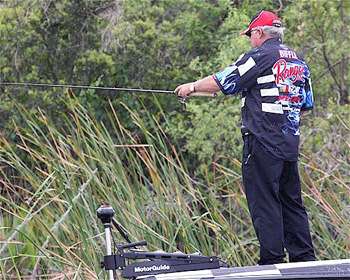
It's hard to imagine having a Thanksgiving turkey without dressing. The same is true when fishing a jig without dressing it with a trailer. And just like at Thanksgiving dinner — where there is often a debate over which kind of stuffing is best — anglers are often at odds over which type of trailer is best for dressing up jigs.
To Elite Series pro Tommy Biffle there is no debating trailer selection. "I use some kind of plastic trailer on all of my jigs," he says. "It really just depends on what they want. It might be a crawdad trailer, or it could be just a chunk trailer — but it's always plastic."
Pork trailers have long been the staple for jig trailers, given their natural buoyancy and lifelike qualities. However, in recent years plastic trailers have taken over the top spot in many anglers' tackleboxes.
For Biffle, however, the decision of plastic over pork was purely monetary. "Every once in a great while, a pork trailer will roll up onto the tip of the hook," he says. "I don't care how hard you set the hook, you're not going to drive through the bulkiest part of a pork trailer.
"Years ago at Sam Rayburn, I had a 5-pounder come off for this exact reason. I lost the tournament by 3 ounces. I swore then that I'll never be in that position again." Whether you're a fan of pork or plastic, the point of the trailer is to add bulk and movement to the jig's profile. But the question of how much action and bulk is often debated.
"If I'm fishing in dirty water, I want the bait as bulky as possible," Biffle points out. "In those situations, I'm going to want to have a big, full skirt and bulky trailer on the hook — particularly if the lake has lots of big fish." Biffle adds that when the water has good visibility or he is trying to increase the number of bites regardless of size, he will use a smaller profile jig and trailer combination.
"I might trim the skirt a little bit and use the crawdad trailer. It's important that whatever trailer you have, it needs to have a little movement." In addition to bulk and movement, anglers have always been told that a trailer can be used to control the jig's rate of fall. "I don't really pay attention to how a trailer will affect the bait's fall rate," Biffle admits. "Most of the time, I'm flipping with a half-ounce jig and I've really never had anyone in the boat beat me by flipping with a lighter jig.
You can control the fall of the bait with your rod. If I have a bulky trailer on there, it's because I want to catch a big bass." When it comes to affixing the trailer to the jig, some thread the trailer onto the jig hook while others simple impale the trailer through the meatiest part. Biffle, who fishes the Triple Rattleback Flipping Jig, has eliminated the guesswork and sticks with one method 100 percent of the time. "Using a Zoom Super Chunk as an example, I'll thread it onto the hook and glue the top of it to the collar of the jig," he explains. "On my craw trailers, I'll do the same thing, but I'll bite a quarter of the tip off and then thread it onto the hook. By gluing them on, you can catch a lot of fish with one trailer."
(Provided exclusively to BASS Insider by Z3 Media)
